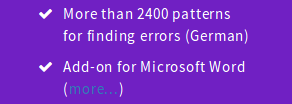Thanks. We currently don’t have a maintainer for Japanese, so there’s no sub page for it and for now no need to have a Japanese translation.
Most people search for grammar checkers for their language with their native language. Japanese does not have many hits, but that may be due to not having a page that can be found when searching for something like: “文法チェッカー” (“grammar checker” Google translated).
This creates a closed cycle where you don’t have users because you don’t have a localised page, and, it seems, you don’t have a localised page because you don’t have users.
Welcoming volunteers may be wise, since they don’t appear that often.
The problem is that “having users” != “having contributors”. But I have added a Japanese translation now and invited Ze Dang.
Hi, dnaber. LanguageTool only supports proofreading reading service in simplified Chinese. I wonder if we should provide a translation in simplified Chinese now.
I cannot decide that, what do you think? Would that be another page, or would the Chinese page then only be in simplified Chinese?
I think not all the people from China can recognize the traditional Chinese characters. However, we actually support the service for the people who use simplified Chinese now. In my opinion, I think it is better to use a simplified Chinese translation version.
In the future, if we support the service in traditional Chinese. We can display two pages one for Chinese(simplified) and the other for Chinese(traditional).
That makes sense, I think. Thanks for the translations so far!
I still think the choice of color for the links on the purple background isn’t great:

I’m not an expert, but I am pretty sure this color combination is almost unreadable for most “visually impaired” users, including color-blind people and pretty much everyone older than fifty years.
What we need is a greater contrast. I would recommend the named color Gold for links on purple background. Yellow or orange would be fine, too. Due to the difference in brightness, even somebody who can’t see any colors should be able to read this.
I would create a special CSS class for those links, say link-secondary, and assign it to the links that appear on purple background.
I’ve changed the color of that link, but I’ll also ask the designer to come up with an alternative color scheme.
I suggest @dnaber to move the current translation on WebTranslateIt to zh_HANT and open a new language under zh_HANS. @t0iiz and I will translate simplified Chinese. The website for now should use the simplified Chinese version, but we should keep the traditional Chinese version for the future.
Should be done now, please let me know if there’s a problem with that.
I can’t access neither zh_HANS nor zh_HANT now, can you give me and @t0iiz translation permissions again? And it would be great if you could upload the strings for zh_HANT to zh_HANS so we can ensure both versions are translated consistently.
Also, the language menu should have separate strings for “Simplified Chinese” and “Traditional Chinese” instead of “Chinese”.
Done.
As Ze Dang wrote above, wouldn’t it make more sense to wait with the traditional Chinese version until LT actually supports it?
What I meant was that “Chinese” should be renamed to “Simplified Chinese” in the menu, and “Traditional Chinese” included as a string to be translated but not pushed to the website frontend.
I see - is there a way to abbreviate that? “Simpl. Chinese” maybe? “Simplified Chinese” would be by far the longest language name.
You can abbreviate it to “Simp. Chinese”, but ideally not.
what about “Simple Chinese”? It should convey the meaning.
But that’s not what it’s called. Simple and simplified have different meanings. Here, Simplified Chinese has its characters simplified but the meaning is identical to Traditional Chinese. This is different from simplifying the syntax, which “simple Chinese” is indicating.